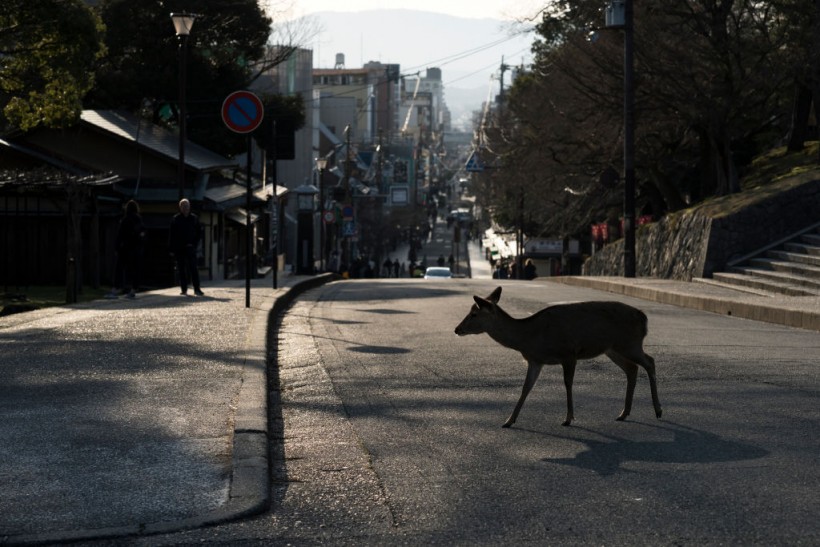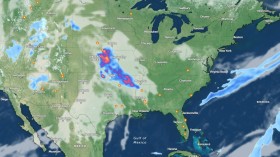Wildlife-vehicle collisions (WVCs) are a serious threat to both human and animal lives, especially at night when visibility is low and animals are more active.
According to a study by the Traffic Injury Research Foundation, the number of persons killed in a motor vehicle collision with wildlife species in Canada ranged from 20 to 45 between 2000 and 2014, and the peak time for these accidents was between 9:00 pm to midnight.
How can drivers reduce the risk of WVCs at night? What factors affect the ability to detect animals on the road after dark? Here are some insights from recent research and experts.
The role of environmental and biological factors
 (Photo : Tomohiro Ohsumi/Getty Images)
(Photo : Tomohiro Ohsumi/Getty Images)

One of the main challenges of avoiding WVCs at night is detecting animals on the road in time to react.
Several environmental and biological factors can influence the detection distance and the reaction time of drivers, such as the weather, the road conditions, the lighting, the speed, the animal size, the animal behavior, and the driver's attention.
A study by Raphaela Pagany from University of Salzburg reviewed 645 publications on WVCs and identified some common factors that increase the likelihood of WVCs, such as the proximity to the forest, a gentle topography with sparse curves, street width, and seasonal differences.
These factors can affect the visibility and the movement of animals on the road, as well as the driver's perception and expectation of encountering wildlife.
Some of these factors are beyond the control of drivers, but others can be modified or mitigated.
For example, drivers can reduce their speed, use high beams when possible, scan the road and the roadside for animal signs, and pay attention to warning signs and reflectors.
Drivers can also learn about the habits and habitats of the local wildlife, and be more cautious during periods of high animal activity, such as dawn, dusk, and mating seasons.
Also Read: Montana Proposes Fences, Gates, Warning Signs to Curb Wildlife Deaths Caused by Vehicle Crashes
The potential of technology and innovation
Another way to prevent WVCs at night is to use technology and innovation to enhance the detection and avoidance of animals on the road.
Some examples of these technologies are roadside animal detection systems (RADS), animal detection and collision avoidance systems (ADCAS), and wildlife warning reflectors.
These technologies aim to alert drivers of the presence of animals on the road or to deter animals from crossing the road, using sensors, cameras, lights, sounds, or other devices.
However, the effectiveness and feasibility of these technologies vary depending on the type, location, cost, and maintenance of the system.
A study evaluated the performance of a RADS in reducing the threat of WVCs during peak tourism periods in a national park in Florida, USA.
The RADS used infrared beams to detect large animals crossing the road and activated flashing signs to warn drivers.
The study found that the RADS reduced the number of WVCs by 66%, and increased the driver's awareness and braking behavior.
They also suggested that the RADS could be improved by adding more sensors, adjusting the sign locations, and integrating the system with smartphone applications.
Another proposed a novel ADCAS using deep learning and object detection techniques.
The ADCAS used a camera mounted on the vehicle to capture images of the road, and a neural network model to detect animals in the images.
It then alerted the driver of the animal's location and distance and activated the brakes if necessary.
The study developed a new dataset of 25 classes of various animals and tested the accuracy and the speed of the ADCAS using two neural network architectures: SSD and faster R-CNN.
According to the researchers, ADCAS achieved a mean average precision of 80.5% at 100 frames per second for SSD and 82.11% at 10 frames per second for faster R-CNN.
A third study assessed the impact of wildlife warning reflectors on the frequency and distribution of WVCs in Germany.
The reflectors used the headlights of the vehicles to create a light barrier along the road, which was supposed to deter animals from crossing.
The study used citizen science data from a smartphone application to collect information on WVCs and analyzed the spatial and temporal patterns of WVCs with and without reflectors.
The reflectors had no significant effect on the overall number of WVCs, but they did reduce the number of WVCs with cervids by 25%.
The study also found that the reflectors had different effects depending on the road type, the road width, the traffic volume, and the season.
The need for more research and collaboration
While these technologies and innovations offer some promising solutions to reduce WVCs at night, they also pose some challenges and limitations.
For example, some of these systems may be expensive, complex, or difficult to install and maintain. Some of them may also have unintended consequences, such as disturbing the natural behavior of animals or creating a false sense of security for drivers.
Moreover, some of these systems may not be applicable or transferable to different regions, species, or situations.
Therefore, more research and collaboration are needed to evaluate the effectiveness, efficiency, and sustainability of these technologies and innovations, and to develop new and better ways to protect both human and animal lives on the road.
Related article: Bird Strikes are an Unreported Threat to US Military Aircraft
© 2024 NatureWorldNews.com All rights reserved. Do not reproduce without permission.



![Roundworms with Short Memories 'Stop Forgetting' When Frozen or Given Lithium [Study]](https://1471793142.rsc.cdn77.org/data/thumbs/full/70295/280/157/50/40/roundworms-with-short-memories-stop-forgetting-when-frozen-or-given-lithium-study.jpg)

